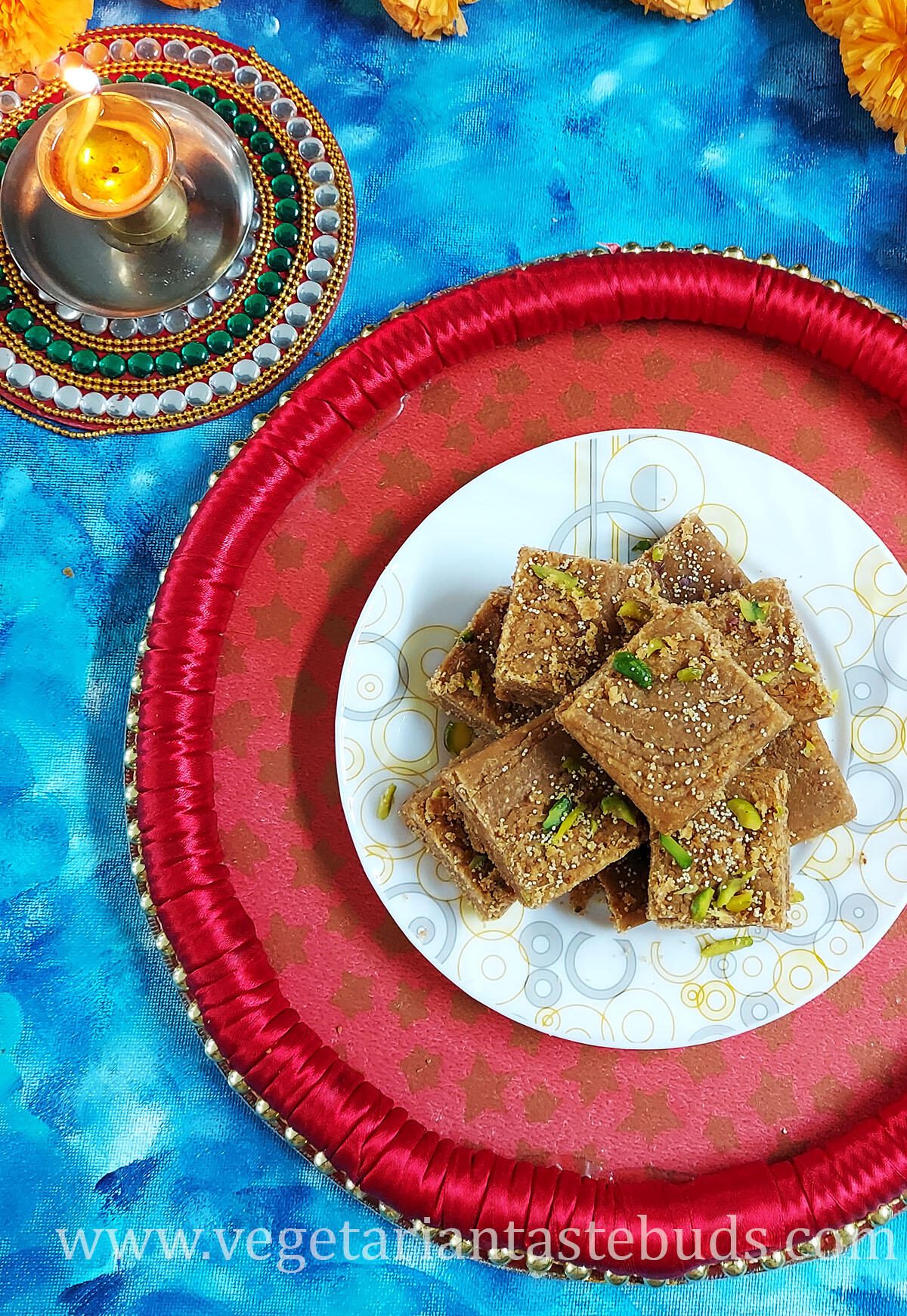
Mohanthal is a traditional Gujarati sweet prepared from besan, ghee, sugar and flavoured with saffron, cardamom and nutmeg. This mohanthal recipe is prepared without mawa and we have shared all the tips & tricks so you can easily prepare the mohanthal this Diwali.
Usually, people get confused between mohanthal, besan ladoo and magas ladoo since all the recipes use the same ingredients. We have already shared the recipe for Magas ladoo or magaj and quick besan ladoo in microwave. The difference lies in the method of preparing these sweets.
Difference between magaj, mohanthal, and besan barfi
Texture – The texture of Magas ladoo and Mohanthal is grainy, whereas besan barfi is smooth.
Sugar – Powdered sugar is added to Magas ladoo, whereas sugar syrup is used for Mohanthal and Besan Barfi.
Process – For Mohanthal and Magaj Ladoo, besan is mixed with milk and melted warm ghee. Then rub between your palms to get a breadcrumb-like texture. This process is called Dhrabo Devo in Gujarati. The process to get the grainy texture. North Indian besan barfi or ladoo is smooth in texture and sugar syrup is added for the sweetness.
Ingredients
Besan
You can use coarse besan or fine besan for making Mohanthal –
- Some prefer the very coarse texture and so use coarse besan and proceed with the dhrabo process
- We have used fine or regular besan for the recipe and then mixed it with milk and warm ghee for dhrabo.
Ghee – Use homemade ghee if possible. For the dhrabo process, use melted warm ghee.
Milk – Use room temperature milk for the dhrabo process. Do not add cold or hot milk.
Sugar – You can use regular granulated sugar.
Milk Powder – Addition of milk powder gives a rich flavor and aroma to the mohanthal. Also, we have not added mawa in this mohanthal recipe, so do not skip adding milk powder for the perfect taste and texture.
Elaichi & Nutmeg Powder – We have added elaichi and nutmeg powder for the flavor. You can add any one or skip both based on your preference.
Saffron Strands (Kesar) – Kesar yields a nice color and also gives a very flavor to the recipe
Nuts & Khus Khus – We have sprinkled sliced pistachios and khus khus on the mohanthal. You can add any of your preferred nuts or can even skip the nuts or khus khus if you do not like them.

How to prepare Mohanthal Recipe without Mawa | Step-by-Step Recipe
Step 1 – Dhrabo – Mix besan, ghee and milk
Sift besan once through a fine sieve and take in a wide bowl. Make a well/hole in the center and add milk and melted warm ghee.
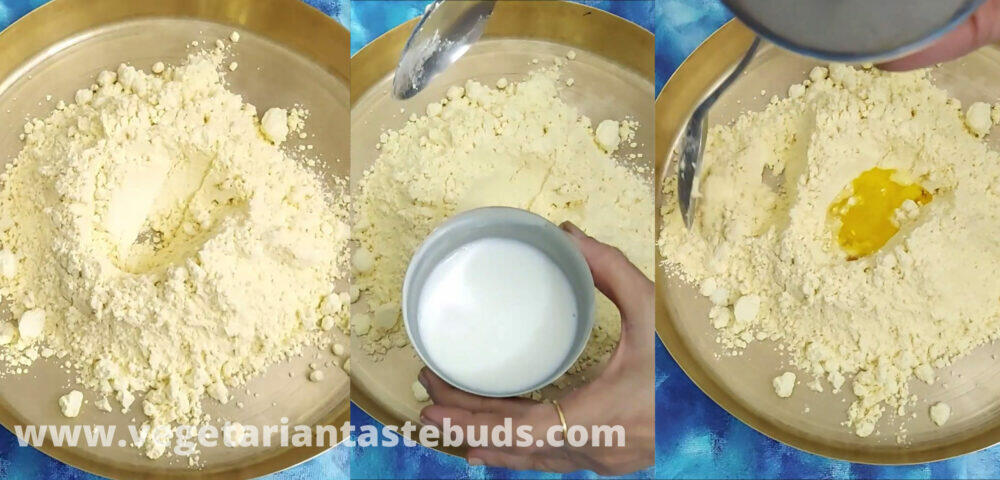
Mix well, first with a spoon, and then rub with your fingers or between your palms to get a crumbly texture. It will resemble breadcrumb-like texture.
Once you notice it has a crumbly texture, press it with your hands or the back of a spoon. Cover and keep this aside for half an hour. This process is called Dhrabo Devo in Gujarati. We are doing this process to get the grainy texture of the mohanthal.

Step 2 – Roasting Dhrabo mixture
After half an hour, sift this mixture through a medium-hole sieve. You can crumble the mixture between your palms to break the lumps, so passing the mixture through the sieve becomes easy.
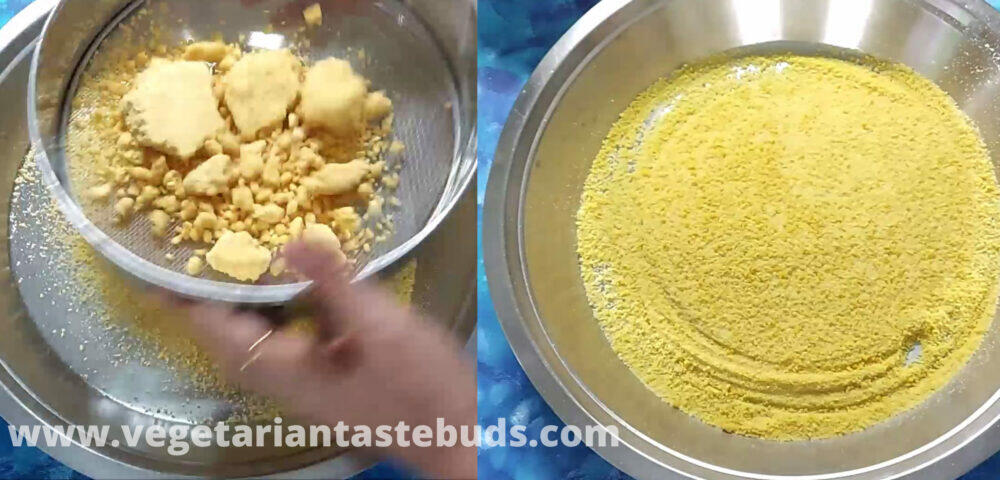
Heat ¾ cup minus 1 tablespoon ghee in a pan on medium flame. In total, we have used ¾ cup ghee, out of which 1 tablespoon we have mixed with besan for dhrabo.
Once ghee starts melting or becomes little warm, add besan mixture to it. Do not let the ghee become too hot, otherwise, there will be a typical smell in your mohanthal.

Immediately start stirring and keep mixing. Cook on low-medium flame for 10-12 minutes and keep stirring continuously. Cook this mixture on a low flame till it becomes brown in colour and fragrant. It will also become light and airy, which you will notice while stirring. Keep stirring continuously till it is done.
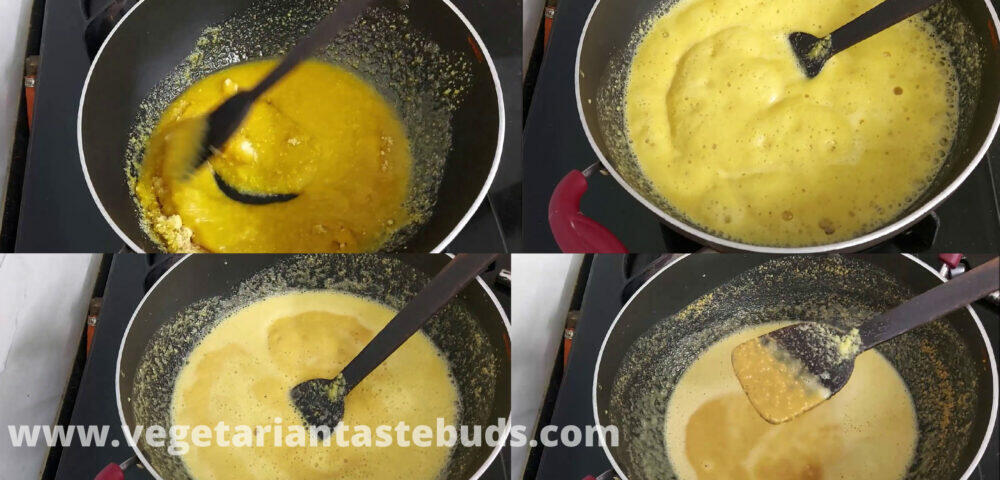
Switch off the flame and add 2 tablespoons of milk powder and keep stirring and mixing for about 1-2 minutes.

For elaichi powder, dry roast 10-12 elaichi/cardamom for 2 minutes on low flame. Keep stirring. Remove from flame, let it cool. Once cool, you can peel them easily to remove their seeds. Crush using a mortar and pestle.
Step 4 – For the sugar syrup
In a pan, combine sugar and water, and let it cook on a medium flame.
Once the sugar syrup becomes hot, take out a spoonful syrup in a bowl and add kesar to it. Let it sit for some time.
Once the syrup comes to a boil, reduce the flame to low and allow to simmer until you get a 1.5 string (thread) consistency. Once you notice that the syrup has thickened, switch off the flame and take out little quantity on a plate. Once it cools check the consistency.
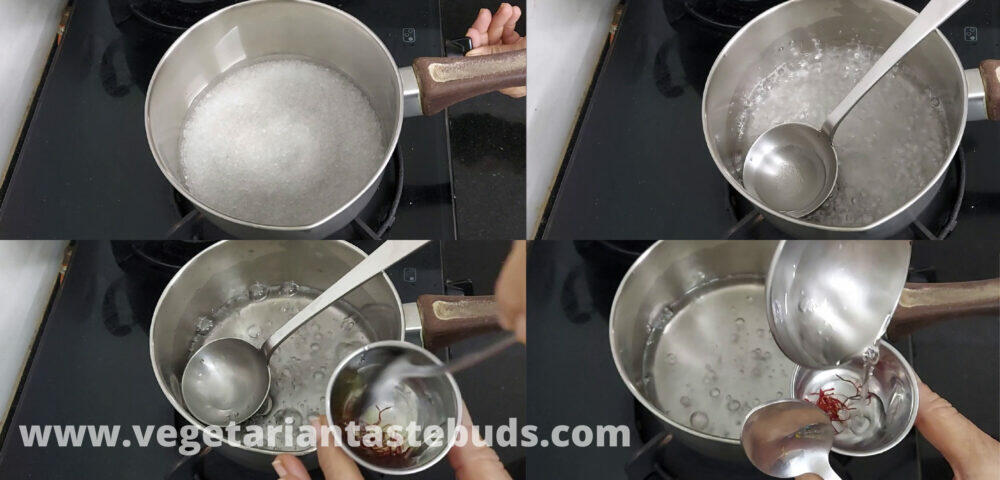
To check, place a drop of syrup between your finger and thumb and draw them apart, you should observe one firm string and one breaking in between. That is one and a half strings.
Switch off the flame and add cardamom powder, nutmeg powder, and kesar soaked in syrup. Mix. Do not switch on the flame and cook the syrup after achieving the desired string consistency. Otherwise, syrup will become thicker.


Step 5 – Preparing Mohanthal
Immediately add sugar syrup to the besan mixture gradually. When you add sugar syrup, besan mixture should be hot/warm, it should not be cold/room temperature. Sugar syrup should be boiling hot. Mix. Do not switch on the flame while doing this process.

Pour this mixture into a greased plate/tin, sprinkle chopped pista and khus khus. Let it cool down for 10 minutes. Once it sets a bit, cut it into square pieces. We just have to make square markings so that it becomes easy to remove the pieces once it is cooled.
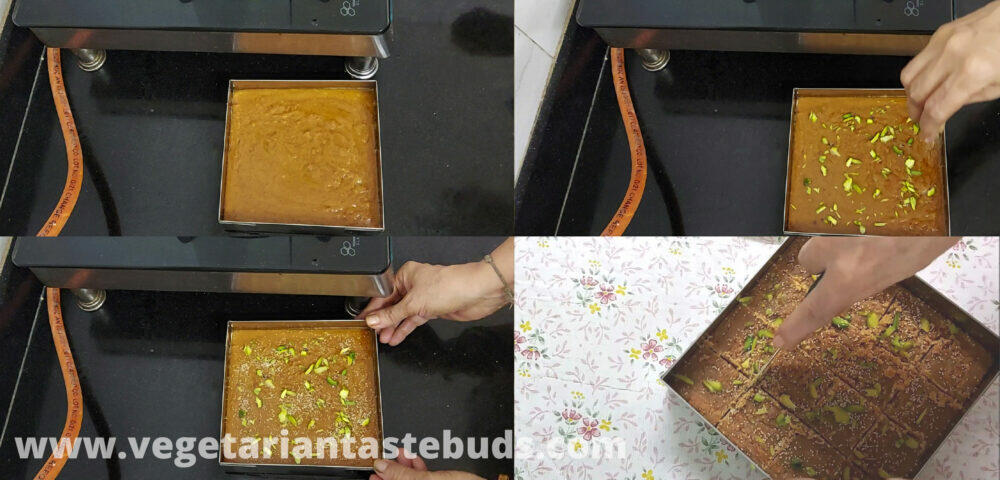
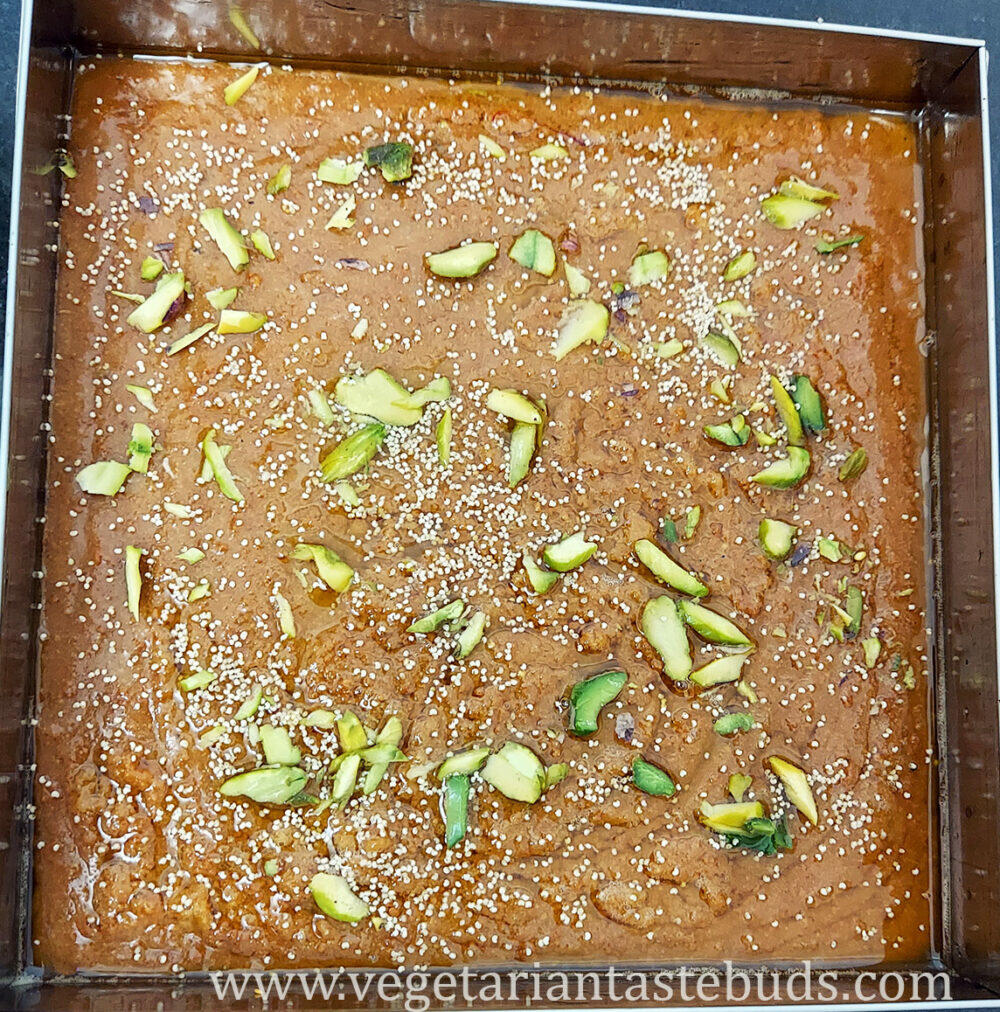

Do not remove the pieces at this stage. Now let it set.
Once it is set, again run the knife through the markings and cut it into square pieces. Remove the pieces and store them in an air-tight container.
Pro Tips
- Warm ghee and room temperature milk – For the dhrabo process, make sure the ghee is warm and the milk is at room temperature.
- Do not let the ghee become too hot before adding the besan mixture: while adding the besan mixture to ghee for roasting, add it immediately once the ghee starts melting or becomes a little warm. Do not let the ghee become too hot, otherwise, there will be a typical smell in your mohanthal.
- Add milk powder only after switching off the flame: Switch off the flame before adding milk powder and keep mixing for about 1-2 minutes. But add it immediately after you notice that the mixture is roasted well.
- Adding sugar syrup to the roasted besan mixture: when you add sugar syrup, the besan mixture should be hot/warm, it should not be cold/room temperature. Sugar syrup should be boiling hot. Do not switch on the flame while doing this process.
- Do not skip the dhrabo process: the process is done to acquire the grainy texture of mohanthal.
- Sift the besan: before you proceed with the dhrabo process, sift the besan and then use it.
- Sugar Syrup: Do not switch on the flame and cook the syrup after achieving the desired string consistency. Otherwise, syrup will become thicker.
More Sweets & Desserts Recipes
Kaju Katli without sugar syrup
Recipe Card

Mohanthal Recipe without Mawa
Loved this recipe? Leave a comment below and give us a 5★ rating
Ingredients (1 cup = 240 ml)
To be mixed (it is called Dhrabo in gujarati)
- 2 cups besan/chickpea flour/gram flour
- 1 tablespoon milk room temperature
- 1 tablespoon melted ghee warm
For the sugar syrup
- ¾ cup sugar
- ½ cup water
Other Ingredients
- ¾ cup minus 1 tablespoon ghee in total we have used ¾ cup ghee, out of which 1 tablespoon we have mixed with besan for dhrabo
- 2 tablespoon milk powder
- 8 to 10 saffron strands
- 1 teaspoon cardamom/elaichi powder
- ¼ teaspoon nutmeg/jaiphal powder or grated jaiphal
For the garnish
- 1 teaspoon poppy seeds/khus khus
- 8-10 pistachios/pista chopped
Instructions
Step 1 – Dhrabo – Mix besan, ghee and milk
- Sift besan once through a fine sieve and take in a wide bowl. Make a well/hole in the center and add milk and melted warm ghee.
- Mix well, first with a spoon, and then rub with your fingers or between your palms to get a crumbly texture. It will resemble breadcrumb-like texture.
- Once you notice it has a crumbly texture, press it with your hands or the back of a spoon. Cover and keep this aside for half an hour. This process is called Dhrabo Devo in Gujarati. We are doing this process to get the grainy texture of the mohanthal.
Step 2 – Roasting Dhrabo mixture
- After half an hour, sift this mixture through a medium-hole sieve. You can crumble the mixture between your palms to break the lumps, so passing the mixture through the sieve becomes easy.
- Heat ¾ cup minus 1 tablespoon ghee in a pan on medium flame. In total, we have used ¾ cup ghee, out of which 1 tablespoon we have mixed with besan for dhrabo.
- Once ghee starts melting or becomes little warm, add besan mixture to it. Do not let the ghee become too hot, otherwise, there will be a typical smell in your mohanthal.
- Immediately start stirring and keep mixing. Cook on low-medium flame for 10-12 minutes and keep stirring continuously. Cook this mixture on a low flame till it becomes brown in colour and fragrant. It will also become light and airy, which you will notice while stirring. Keep stirring continuously till it is done.
- Switch off the flame and add 2 tablespoons of milk powder and keep stirring and mixing for about 1-2 minutes.
- For elaichi powder, dry roast 10-12 elaichi/cardamom for 2 minutes on low flame. Keep stirring. Remove from flame, let it cool. Once cool, you can peel them easily to remove their seeds. Crush using a mortar and pestle.
Step 3 – For the sugar syrup
- In a pan, combine sugar and water, and let it cook on a medium flame.
- Once the sugar syrup becomes hot, take out a spoonful syrup in a bowl and add kesar to it. Let it sit for some time.
- Once the syrup comes to a boil, reduce the flame to low and allow to simmer until you get a 1.5 string (thread) consistency. Once you notice that the syrup has thickened, switch off the flame and take out little quantity on a plate. Once it cools check the consistency.
- To check, place a drop of syrup between your finger and thumb and draw them apart, you should observe one firm string and one breaking in between. That is one and a half strings.
- Switch off the flame and add cardamom powder, nutmeg powder, and kesar soaked in syrup. Mix. Do not switch on the flame and cook the syrup after achieving the desired string consistency. Otherwise, syrup will become thicker.
Step 4 – Preparing Mohanthal
- Immediaely add sugar syrup to the besan mixture gradually. When you add sugar syrup, besan mixture should be hot/warm, it should not be cold/room temperature. Sugar syrup should be boiling hot. Mix. Do not switch on the flame while doing this process.
- Pour this mixture into a greased plate/tin, sprinkle chopped pista and khus khus. Let it cool down for 10 minutes. Once it sets a bit, cut it into square pieces. We just have to make square markings so that it becomes easy to remove the pieces once it is cooled.
- Do not remove the pieces at this stage. Now let it set.
- Once it is set, again run the knife through the markings and cut it into square pieces. Remove the pieces and store them in an air-tight container.
Video
Notes
- Warm ghee and room temperature milk – For the dhrabo process, make sure the ghee is warm and the milk is at room temperature.
- Do not let the ghee become too hot before adding the besan mixture: while adding besan mixture to ghee for roasting, add it immediately once the ghee starts melting or becomes a little warm. Do not let the ghee become too hot, otherwise, there will be a typical smell in your mohanthal.
- Add milk powder only after switching off the flame: Switch off the flame before adding milk powder and keep mixing for about 1-2 minutes. But add it immediately after you notice that the mixture is roasted well.
- Adding sugar syrup to the roasted besan mixture: when you add sugar syrup, the besan mixture should be hot/warm, it should not be cold/room temperature. Sugar syrup should be boiling hot. Do not switch on the flame while doing this process.
- Do not skip the dhrabo process: the process is done to acquire the grainy texture of mohanthal.
- Sift the besan: before you proceed with the dhrabo process, sift the besan and then use it.
- Sugar Syrup: Do not switch on the flame and cook the syrup after achieving the desired string consistency. Otherwise, the syrup will become thicker.
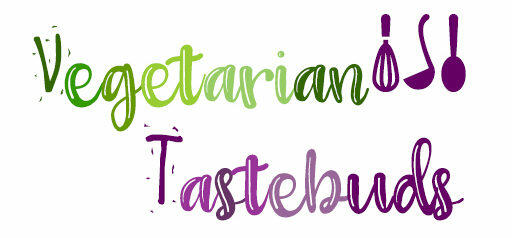
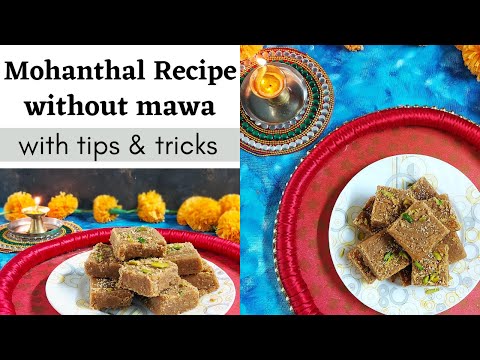
Leave a Reply